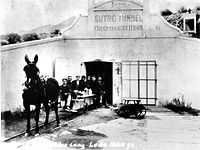Sutro Tunnel
| Sutro Tunnel | |
|---|---|
 The entrance to the Sutro Tunnel in the late 1800s | |
Nevada Historical Marker | |
| Reference No. | 85[1] |
The Sutro Tunnel is a drainage tunnel ( adit ) connected to the Comstock Lode in Northern Nevada. It begins at Virginia City, Nevada and empties approximately 6 miles southeast near the town of Dayton, Nevada.
The tunnel was first envisioned by Adolph Sutro in 1860. He promoted the drainage tunnel in order to allow access to deeper mineral exploration in the Comstock. Mine flooding and inadequate pumps had inhibited some exploration activities up to that time.
By 1865, Sutro's idea had gained the approval of state and federal legislation. The mining interests of the Comstock also initially supported the tunnel project, but later strongly opposed the idea. They feared that an alternate access point to the Comstock minerals would threaten their monopoly on the mining and milling of gold and silver in the Comstock.
Nonetheless, Sutro formed the Sutro Tunnel Company, selling stock certificates to raise funds for its construction, which began in 1869. Financing also came from local miners under the guise of improved mine safety. This was further advocated (perhaps exploited) by Sutro after the Yellowjacket mine disaster where dozens of miners were burned to death because they could not escape the mine.
Arthur De Wint Foote worked on the tunnel in 1873, but was fired in 1874, having struck a flood of water in Shaft No. 2.[2]
The main tunnel was completed in 1878. By that time, however, the Comstock mine had gone deeper, using newer improved pumps, and was also thinning out. Lateral tunnels were also created to enhance drainage and ventilation. Upon completion, Adolph Sutro immediately sold his interest in the tunnel company and moved to San Francisco, later becoming mayor of that city.
The Sutro Tunnel pioneered the excavation of large drainage and access tunnels in the United States. Later US mine drainage tunnels included the Argo Tunnel at Idaho Springs, Colorado, the Leadville and Yak tunnels at Leadville, Colorado, and the Roosevelt tunnel in the Cripple Creek district, Colorado.
References
- ↑ "Nevada Historical Markers". Nevada State Historic Preservation Office. Retrieved 23 February 2013.
- ↑ Rickard, Thomas Arthur (1992). Interviews with Mining Engineers. San Francisco: Mining and Scientific Press. p. 172. OCLC 2664362.
External links
Further reading
- Sutro, Adolph (1865). The Advantages and Necessity of a Deep Drain Tunnel for the Great Comstock Ledge. San Francisco, CA., Sutro's argument and proposal for the tunnel
Coordinates: 39°16′48.39″N 119°35′3.6″W / 39.2801083°N 119.584333°W
| Preceded by Jedediah Strong Smith |
Nevada Historical Markers 85 |
Succeeded by Tule Springs Archaeological Site |